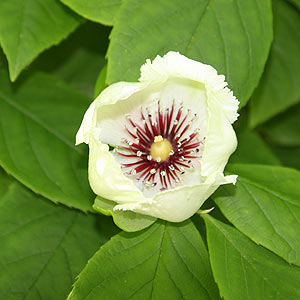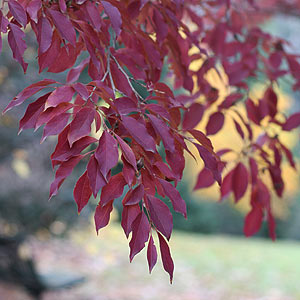
Although Stewartia are commonly called the pseudocamellia these slow growing small trees do differ depending on variety. Many are from Japan and Korea, however some are from south east of the U.S.
In Japan this graceful tree is known as the summer camellia, ‘Natsu no tsubaki’.
Grown for the attractive trunk that over time develops a wonderful orange and red tones, as well as for the flowers that certainly have a WOW factor. The foliage in Fall is also excellent.
Depending on variety you will see them sold as either the Japanese or Korean Stewartia
These are a deciduous tree that have a fairly upright habit when young, tending to broaden out a little as they age.

For us the showiest variety for flowers is S. malacodendron also known as the ‘Silky stewartia’ (pictured upper right). The Korean species is grown more for the brilliant red foliage in fall although again the flowers are attractive.
Depending on species these attractive plants will grow well in USDA zones 5 – 8.
Stewartia Care
Although over time most Stewartia can reach 30ft in height, they are slow growing. In cultivation we have found that the height seems somewhat less.
- Soil Type – Humus rich, moist but well drained soil.
- Position- Part Shade to Full Sun – The warmer the climate the more shade.
- Container growing – Better in the garden than in containers, however they will grow in containers
- Fertilizer- Fertilise Stewartia lightly with a camellia fertilizer in early spring. Repeat this in late summer after the flowers have disappeared.
Stewartia Varieties
- Stewartia pseudocamellia is the Japanese Stewartia,
- Stewartia malacodendron is known as the Silky Stewartia.
- Stewartia sinensis is the Chinese stewartia very attractive peeling bark
- Stewartia rostrata is known as the upright stewartia.
- Stewartia pseudocamellia var. koreana.
- Stewartia monadelpha
- S. ovata
- S. monadelpha
Pruning
All Stewartia have a slow growth rate and require little to no pruning. They naturally develop a good structure, especially if given room so that they do not need to reach for the light.
You can prune individual plants to grow with a single trunk if required, if you do so at a young age.
So we suggest you do not prune Stewartia at all, unless you are removing dead or damaged wood, or taking cuttings for propagation.
Problems – Diseases
Similar to Camellias, Stewartia are relatively problem free if grown in the right conditions.
Stewartia are available for sale from the following specialist nurseries.
DIGGING DOG NURSERY – phone (707) 937-1130PO Box 471 Albion CA 95410A spectacular selection of hard to find perennials, ornamental grasses, shrubs, trees and vines for your garden.Includes: Stewartia pseudocamellia.www.diggingdog.com

